#cosmogram
Explore tagged Tumblr posts
Photo

Source details and larger version.
Here's my collection of vintage heaven imagery.
32 notes
·
View notes
Text
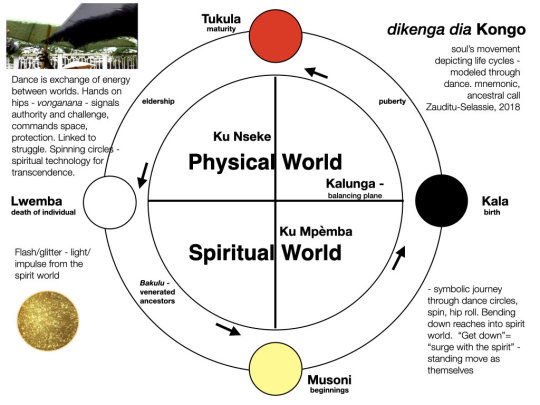
Archeologists also found the Kongo cosmogram on several plantations in the American South; they were Richmond Hill Plantation in Georgia, Frogmore Plantation in South Carolina, a plantation in Texas, and Magnolia Plantation in Louisiana. Historians call the locations where crossroad symbols were possibly found inside slave cabins and African-American living quarters as 'Crossroads Deposits.' Crossroads deposits were found underneath floor boards and in the northeast sections of cabins to conjure ancestral spirits for protection. Sacrificed animals and other charms were found where the crossroads symbols were drawn by enslaved African-Americans and four holes drilled into charms to symbolize the Bakongo cosmogram. Other West-Central African traditions found on plantations by historians is the use of six pointed stars as spiritual symbols. A six pointed star is a symbol in West Africa and in African-American spirituality.
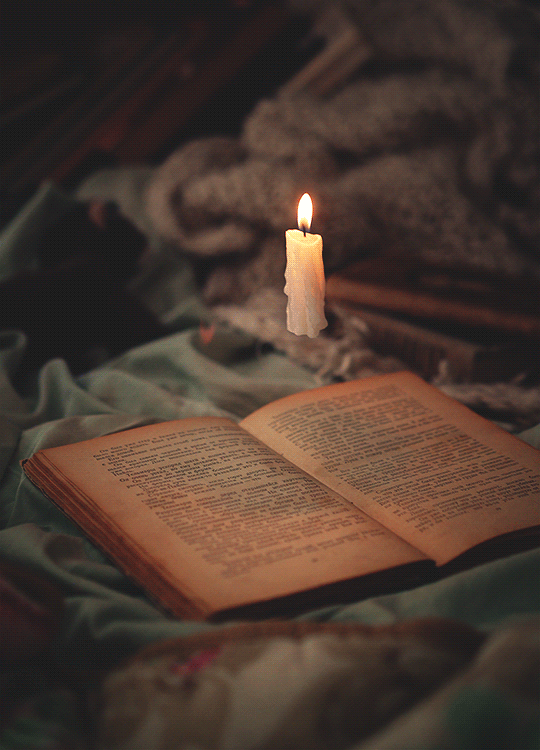
On another plantation in Maryland archeologists unearthed artifacts that showed a blend of Central African and Christian spiritual practices among slaves. This was Ezekiel's Wheel in the bible that blended with the Central African Kongo cosmogram. This may explain the connection enslaved African Americans had with the Christian cross as it resembled their African symbol. The cosmogram represents the universe and how human souls travel in the spiritual realm after death entering into the ancestral realm and reincarnating back into the family. The artifacts uncovered at the James Brice House were Kongo cosmogram engravings drawn as crossroads (an X) inside the house. This was done to ward a place from a harsh slaveholder. Also, the Kongo cosmogram is evident in Hoodoo practice among African Americans. Archeologists unearthed on a former slave plantation in South Carolina clay bowls made by enslaved Africans that had the Kongo cosmogram engraved onto the clay bowls. These clay bowls were used by African Americans for ritual purposes.
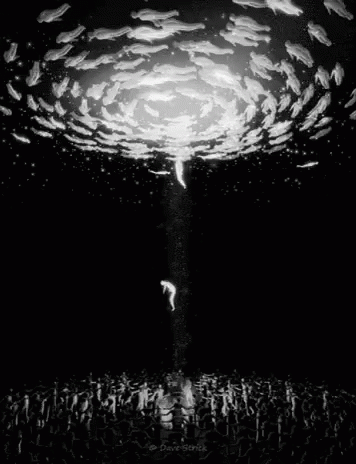
The Ring shout in Hoodoo has its origins from the Kongo region from the Kongo cosmogram (Yowa Cross) and ring shouters dance in a counterclockwise direction that follows the pattern of the rising of the sun in the east and the setting of the sun in the west. The ring shout follows the cyclical nature of life represented in the Kongo cosmogram of birth, life, death, and rebirth. Through counterclockwise circle dancing, ring shouters built up spiritual energy that resulted in the communication with ancestral spirits, and led to spirit possession by the Holy Spirit or ancestral spirits.
Enslaved African Americans performed the counterclockwise circle dance until someone was pulled into the center of the ring by the spiritual vortex at the center. The spiritual vortex at the center of the ring shout was a sacred spiritual realm. The center of the ring shout is where the ancestors and the Holy Spirit reside at the center. The ring shout tradition continues in Georgia with the McIntosh County Shouters. At Cathead Creek in Georgia, archeologists found artifacts made by enslaved African Americans that linked to spiritual practices in West-Central Africa. Enslaved African Americans and their descendants after emancipation house spirits inside reflective materials and used reflective materials to transport the recently deceased to the spiritual realm. Broken glass on tombs reflects the other world. It is believed reflective materials are portals to the spirit world.
#bakongo#kongo#congo#cathead creek#mcintosh county#african american#west central africa#spiritual vortex#cross#cosomogram#yowa cross#cosmogram#african#afrakan#kemetic dreams#brownskin#africans#afrakans#african culture#afrakan spirituality#Ezekiel's Wheel#Magnolia Plantation
79 notes
·
View notes
Video
youtube
Continuing the BaKongo Way: Tracing the BaKongo Cosmogram/Kongo Cross bakongo
#youtube#Continuing the BaKongo Way: Tracing the BaKongo Cosmogram/Kongo Cross bakongo#Bakongo#Jamaica#Obeah#Congo#Kongo
4 notes
·
View notes
Note
Don’t think you read what I said.
“There aren't a lot of human NPCs as it is. Which brings me to your next point...”
I’m agreeing with you. I literally say this in my response. Also, those June NPCs were retired— I wouldn’t count them or the retired June event as a whole.
“There’s a lot of African culture in the game.”
…Where?? There’s one African clothing decor, we’re missing major decors of African animals (we just got hippos in December of 2024), our events center around Western concepts and themes— Egypt has been historically whitewashed and is thematically very safe (not to mention it’s just… furry Gods. The only African decor there is from ancient Egypt) The Gods from the July event only share similarities in names and nothing else. Africa is not a singular culture— both of what I’ve mentioned is from South African (Egypt and Nubia respectively) and don’t contain a crumb of mythos outside of names (I actually think the June event does an okay job at re-writing mythos, but the writing being subpar really stops it from being amazing). Replacing the June event’s unique experience and decently researched unknown culture with the safe Egyptian furries will always make me upset.
Indigenous American and African cultures often go hand in hand. This is why you see semblances of Indigenous American culture in modern African American culture— because many of their core ideologies (mostly the West Coast of Africa) were very similar, their cultures could co-exist and eventually combine relatively easily (although these tribes are not recognized by the United States for being “too black.”) the only time I’ve seen people complain about ‘cultural appropriation’ is with the headdresses (and some other decor), which do look extremely similar to several I’ve studied that are reserved for chiefs using the sacred eagle feather (eagle feathers are sacred in many tribes). That is just one of thousands of tribes, and I cannot speak for every one, but it is a valid and genuine concern.
Finally, what few references to “African Culture” you do mention are from The Lion King. The ancestors being in the stars calls back to a particular African Myth (from what region I cannot currently recall), and the “Circle of Life” is the Kongo Cosmogram. That is as far as explore references go, at least from what I’ve experienced and seen on the Wiki in Explore; they watched a very popular movie to learn about African cultures, most of which can be found in African American Traditional Religion. Should I pat them on the back?
And that’s not even mentioning the misuse of Ancestors and spiritual African terms in the November event, the Westernization of the July overhaul, the painfully western October and April event, and so-on. I have lots of experience in what I’m talking about, I work to preserve African American, Indigenous American, and occasionally African literature and culture. I would happily educate you, but it’d take far longer then this ask.
.
9 notes
·
View notes
Text
FFRMC Day 28: Tragically abandoned wip
Caïssa by cosmogram
enemies to friends to lovers | pining | bickering | seduction | chess
The metaphors, the tension, the vulnerability. Truly beautiful work. These two idiots...
7 notes
·
View notes
Text
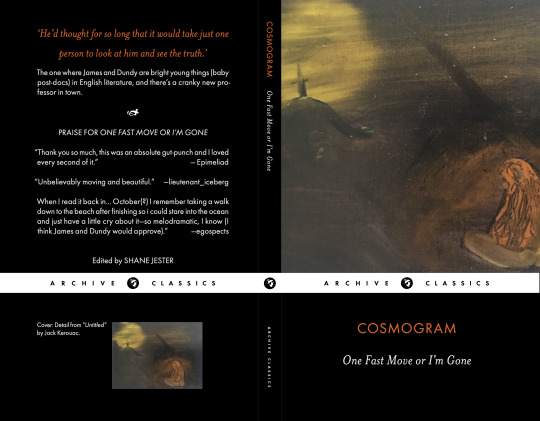
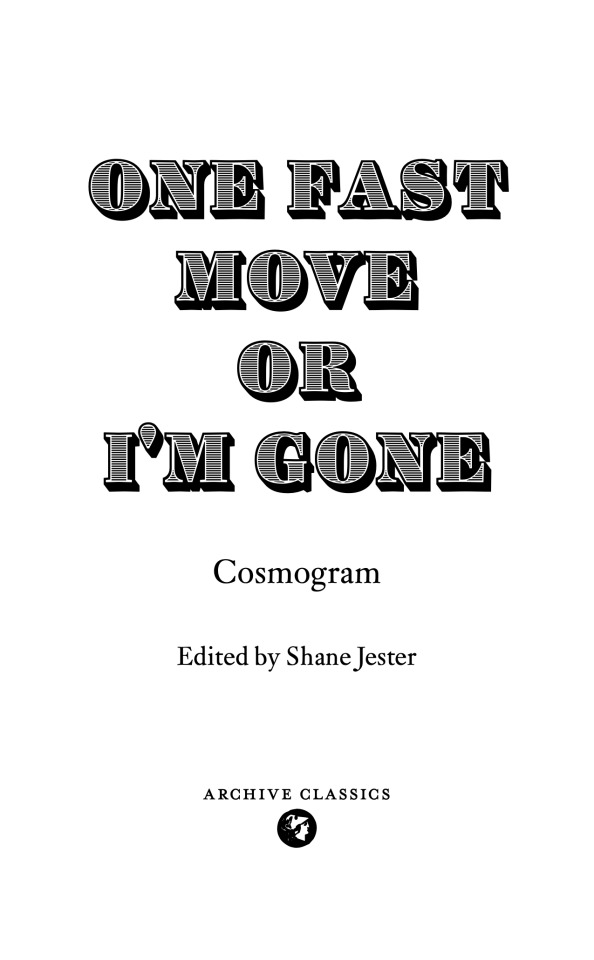
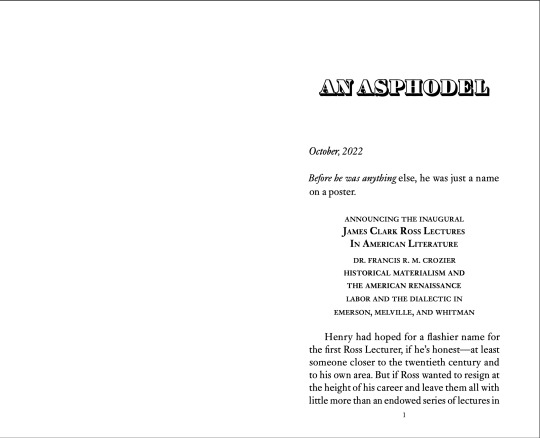
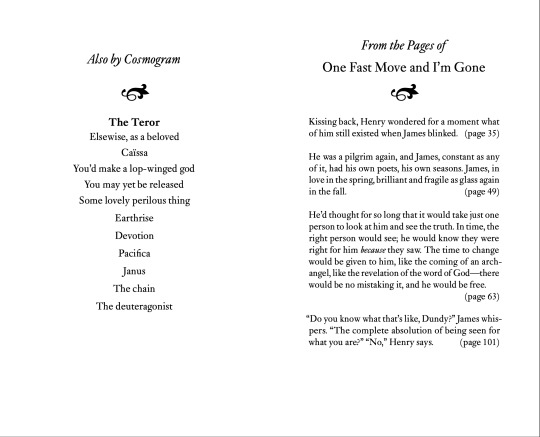
One fast move or i'm gone by cosmogram
cover + typesetting done in Adobe InDesign
the full pdf
#archive classics#the terror#James Fitzjames#dundy le vesconte#fitzconte#francis crozier#fitzier#typesetting#ao3#fanfiction#fanbinding
19 notes
·
View notes
Text
weirdly, from what i can tell the role of crossroads in voodoo magic is unrelated to its role in european magic. actually there might be three totally distinct origins in west africa, britain, and greece. would britain have recieved the influence re: hecate that associated magic and crossroads? i guess magic lore can travel pretty far... anyway i THINK the european stuff traces to hecate but the african stuff related to the kongo cosmogram which has the crossorads as a "meeting place" between two worlds, and so the place you go to interface with the spirits. i guess the same logic could have applied in greece. from the wikipedia page it seems like she was a goddess of boundaries/liminality first and then became a witchcraft god so this story seems at least plausible
24 notes
·
View notes
Text

CONOCE AL PERSONAJE: 09.
Seyram Skylar.
1. Frase que te defina.
«Hay dos tipos de problemas: los que no tienen solución y los que se solucionan todos; yo me angustio por ambos».
2. 5 cosas sin las que no podrías vivir.
-El café de especialidad. -Mi rutina de ejercicio. -El régimen de semi-esclavitud que me incluye el tratamiento Bio-Em. -El paracetamol -El Cosmogram y los sistemas de mensajería.
3. La canción de la que nunca te cansas.
Castle of Glass – Linkin Park
4. ¿Qué haces cuando estás ansioso para calmarte?
¿Calmarse? ¿Quéeseso?
Es broma, es broma. A ver, si de verdad no puedo manejarlo, el Diazepam es mi amigo. Pero normalmente no me hace falta llegar a ese extremo. En esos momentos el ejercicio es lo que mejor me va, me despeja la cabeza.
5. ¿Cuál es la lección más valiosa que has aprendido este último año de tu vida?
Que a veces los cambios no son del todo malos y aferrarte a lo que conoces con tanto ahínco, negándote a abrir a otras ideas, puede hacerte perder muchas buenas oportunidades.
6. Dale un consejo a tu yo de 18 años.
No puedes hacer todo solo. No eres tú contra el mundo.
7. Si pudieras extinguir una quimera para siempre, ¿cuál sería? ¿Y por qué el Blop?
Nunca me he enfrentado a un Blop, así que yo diría los Lepurantas. Recuerdos de Vietnam (previos al nerfeo…).
8. Si se te presentara el genio de la lámpara, ¿qué tres deseos le pedirías?
Creo que con uno solo me valdría: que la Convergencia nunca hubiera existido, ser normal. Pero bueno, ya que los otros dos son gratis: parar el tiempo (para dormir) y la caída del capitalismo.
9. ¿Hay alguien a quien admires profundamente? De ser así, ¿quién es y por qué?
Por supuesto que podría decir aquí nombres de compañeros que son profesionales como la copa de un pino, pero ¿admirar como tal? Si de algo estoy seguro es que no sale nada bueno de poner a la gente en pedestales. Se pierde la perspectiva.
10. Dinos una cosa sobre ti que la gente asume erróneamente que te define o que tienes.
Que por hacer yoga no tengo fuerza. Levanto más peso en las sentadillas que Trevor.
7 notes
·
View notes
Photo

Source details and larger version.
Some strange and unusual vintage diagrams.
28 notes
·
View notes
Note
Ok. Any "Terror" fic recommendations?
good lord YES countless really. idk what you're looking for specifically though.
i myself am a fitzier girlie first and foremost with some occasional fitzconte thrown in. i'll best direct you to my ao3 bookmarks, specifically to the tag i keep for my personal favourites, the crème de la crème of fics I've read and liked.
some examples under the cut.
i am a connoisseur of ✨fitzier hatesex✨ and there's surprisingly not that many of those compared to fics where they're all lovey-dovey with each other (which. dont get me wrong. i also enjoy from time to time). so i'll give you some that have truly stuck with me. it's mostly pwp sorry not sorry.
Some lovely perilous thing by cosmogram
“Oh,” James gasps, and really, it’s almost too easy. James ought to have some modicum of shame, ought to be able to master himself better than this—better than turning to a doe-eyed dissolute the second a man so much as breathes near his eager young cock. “Not here, Francis,” James pants out, voice already hitching high. “The great cabin, at the very least.”
“Here, I think,” Francis returns crisply. “On your knees.”
it's just so fucking good. very hot. i honestly don't know what else i could say about this, it's one of my personal favourites amongst personal favourites (along with the one i link next, from the same author).
Devotion by cosmogram
Francis does not seek him anymore, but neither—still worse—does Francis bother to dismiss him when James arrives of his own volition, each time with all the hope of the most wretched fool. “Oh, get to it, then,” Francis muttered with sublime disinterest that very day when James appeared in his cabin’s doorway. James had, in fact, come to talk—but he had not hesitated when Francis gestured dispassionately to the front of his trousers. He had dropped, wordlessly, to his knees to obey.
everyone give it up for erectile dysfunction! hip-hip hurray! the author sums it up well with the James Fitzjames’s Tragically Unmet Praise Kink tag. this one is a little more on the sad side, Francis is being a goddamn gremlin and James is at his most needy and pathetic. nothing hotter to me personally than sucking someone's limp dick and crying about it. i find myself thinking about this fic an ungodly amount. i love it so much. again, best of the best of the best.
nice dream by icicaille
Francis swirled the last dregs in his glass and peered into its depths. Some kind of grim satisfaction had come over him. “I’ll tell you what you want to hear,” he said. “For a certain price.” It was foolhardy beyond measure. Damning, even.
basically, Fitzjames gives Crozier a blowjob in exchange for Francis telling him some nice reassuring things he needs to hear so badly it makes him look stupid - malicious compliance from Francis of course with some nice internalised homophobia. James is, again, pathetic as all shit with a little twist at the end. no one is having a good time except for me of course.
hunger's vocabulary by icicaille
“Ah, Sir John.” Francis cleared his throat once the wardroom was near to empty. “May I borrow James? Regarding the Lloyd’s balance. We took readings that require further inspection. I’ll send him back in a gig—tonight if the weather holds, in the morning otherwise.”
chef's kiss. just two cunty cunts going at it (the dialogues are so good...) with a sprimkle of some angsty self-loathing Francis. what more could you ask for.
you are coming down with me by dazydaisy
Chapter one: “If I loved you I could perhaps fuck you as if I hated you, in order to please you, but, as you are surely aware by now Fitzjames, you and love are oil and water to me.”
Chapter two: ‘Maybe,’ James had begun to unlace the front of his trousers with a carelessness he had (shamefully) practiced, ‘if you loved yourself even a little you would be able to stop yourself from doing as I command. But, as I’m sure you know by now Francis, you and love are like oil and water. The two simply do not meet.’
*
Mum and dad are fighting again
pretty much what it says on the tin. just two heartbroken bitches fucking and being cruel to each other and im eating that shit up thanks
A Willing Foe and Sea-Room by ClutchHedonist
“Nnh.” Fitzjames whines around his thumb.
“None of that. Clearly, you can’t shut your own bloody mouth to save your life.” Francis huffs, “So I’ll shut it for you.”
pre-canon. Fitzjames - still as a baby lieutenant - and Crozier have a brief but very hot encounter during some Admiralty Party.
Caïssa by cosmogram
“You said you had a question,” Francis snapped, irritable already.
“Yes,” James said, flushed and resplendent still from the company next door—undaunted and loose-limbed in just the way that plucked cloying ire from a raw place in Francis. “How’s your chess game?”
A seduction.
a little bonus to the list, because i love this fic and it recently updated after a very long hiatus (it's still a wip tho but i hope the author manages to finish it, they're one of my favourite writers in this fandom). no hatesex here, it's more of a slow-burn with past Crozier/Ross and really great dialogues, as always. Neptune also makes an appearance.
Bespoke by ktula
James is trying to escape his grief after Sir John's death. Francis, in his own way, is trying to do the same. OR: The one where James Fitzjames has a bit of the genders, and his captain is surprisingly accommodating of that.
ending this rec list on a kinder and softer note, as a treat. this was one of the first fics ive read in this fandom and still one of my favourites. not really hate sex though they're still rather uncertain and wary about the other. very good, very sensual, gender-heavy. beautiful fic really.
BONUS have some excellent fitzjames/le vesconte and fitzjames/franklin - as a treat.
you don't have friends (you have admirers) by JamesFitzjames
James Fitzjames is a man who does not seek help.
each chapter deals with something different, so while the fic is unfinished it's not really some painful cliffhanger (tho i would love to see it completed one day). second chapter is some excellent, excellent Fitzconte. last chapter also has, why, of course, some really delightful ✨fitzier hatesex✨.
Hoo-ray and up she rises by TheGreenMeridian
They’re rip-roaringly drunk and laughing loud enough at each other to wake half the neighbourhood as they stumble into their lodgings.
i only like Fitzconte if it's done in a very specific way and this fic fits my needs just perfectly. just two besties being sillayyyy. what, like you never gave your bro a handjob just for shits and giggles?
Whatever morning brings by isamariposa
Brutus spends his life torn between disquiet, distaste and desperate pining for Caesar, leading to his infamous betrayal. In his own final moments, he raises a plea: “Jupiter Maximus, take pity on me. If by Your grace there is a way to atone for what I did to him, I beg You: let me do so in the afterlife.”
His wish is granted.
yes, yes, this is technically an HBO Rome fic but each chapter deals with a different time period - the third is dedicated to The Terror and can totally be read on its own. it's some truly excellent Sir John/Fitzjames with a sprimkle of some delightful Fitzconte tomfoolery. It's really, really good.
okay one last BONUS
devourer of debts by allmyloyaldead(van1lla_v1lla1n)
Cornelius Hickey receives, and devours, and adapts.
What Hickey receives from the universe and what he takes for himself, the pieces with which he sews himself together into a man, or something like one.
some incredible Hickey insanity. truly brilliant. the gifts Hickey receives from Billy, Irving and Fitzjames, short and sweet (by sweet i obviously mean gruesome and fucked up <3)
#the terror#fitzier#fitzconte#those are just a few really. couldn't possible list them all. just take and eat from my bookmarks dear <3#this fandom is full of SO many incredibly talented people. so many truly gorgeous fics.#the terror fic rec#fic rec
48 notes
·
View notes
Text
More on Hoodoo (spirituality)
In my previous post I talked about traditional hoodoo where it started I want to talk a little more on it.
Let's start with this 'The origins of the word Hoodoo which actually comes from the real term "Hudu", meaning "spirit work," coming from the Ewe language spoken in the West African countries. No. It does not come from Africa but African Americans in the American south.
As I mentioned in a past post the term Hoodoo mean that you are sending someone up the river, the upper room. aka death. This is what it means. But in this time it's use to represent all forms of root work in this practice or others. This was started by marketeers.
SWEETENING JARS:
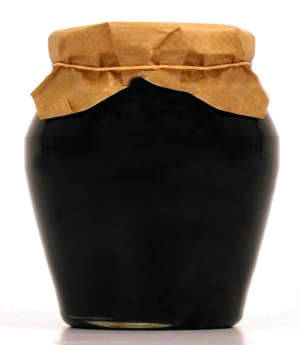
Traditional Sweeting Jar
Sweetening jars is traditional in Hoodoo to sweeten a person or a situation in a person's favor. The practice is appropriated and its meaning is misunderstood outside the African-American community. Traditionally sugar is added to water and used.. Not Honey.
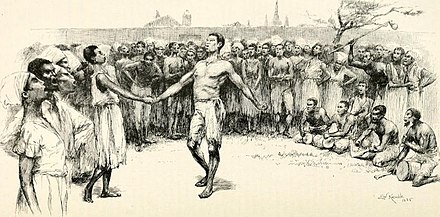
During the slave trade, the majority of Central Africans imported to New Orleans, Louisiana were Bakongo (Bantu people). This image I like and wanted to show it if anyone hasn't seen it. It was painted in 1886 and shows African Americans in New Orleans performing dances from Africa in Congo Square. Congo Square was where African Americans practiced Voodoo and Hoodoo. ("So again when any non traditional Root Worker says there isn't a little voodoo with hoodoo there wrong")
Next we have this diagram the Kongo Cosmogram Cross.
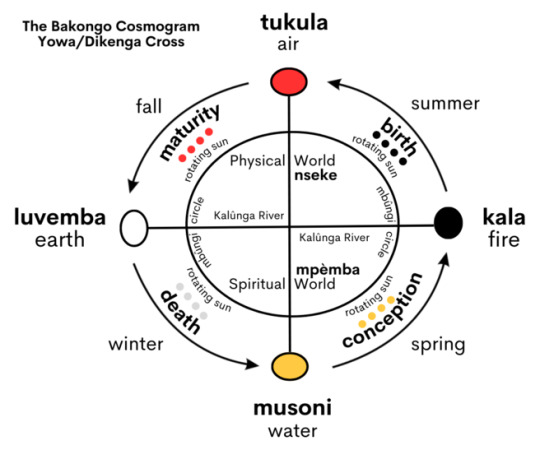
Kongo Cosmogram aka Crossroads.
The Kongo cosmogram aka The Crossroads is from Bakongo origins. This shows how different African religions teach simulator things.
Why is it important? The basic form of this symbol is a simple cross (+) which (symbolizes the rising of the sun in the east, the setting of the sun in the west, and represents cosmic energies.)
This shows that we do use the sun but not the moon like books may teach.
However, the cross is not the same as your typical Christian cross.
The vertical line of the cosmogram is the path of spiritual power from God at the top traveling to the realm of the dead below where the ancestors reside.
The horizontal line in the cross represents the boundary between the physical world which is the (realm of the living) and the spiritual world (realm of the ancestors).
The horizonal line is a watery divide that separates the two worlds from the physical and spiritual, and thus the "element" of water plays a role in African American spirituality just like Voodoo.
The Kongo cosmogram cross symbol has a physical form in Hoodoo called the crossroads where Hoodoo rituals are performed to communicate with spirits.
Dancing: Counterclockwise sacred circle, dances in Hoodoo are performed to communicate with ancestral spirits using the sign of the Yowa cross.
The Ring shout Is Not Part of traditional Hoodoo as far as the actual rituals are concerned, but it is part of church that has its own origins. The ring shout follows the cyclical nature of life that we see in the diagram. It represents Kongo cosmogram of birth, life, death, and rebirth.
Through counterclockwise circle dancing, ring shouters built up spiritual energy that resulted in the communication with ancestral spirits, and led to spirit possession by the Holy Spirit or ancestral spirits. The spiritual vortex in the center of the ring shout is a sacred spiritual realm. The center of the ring shout is where the ancestors and the Holy Spirit reside at. The ring shout tradition continues in Georgia. Inside reflective materials and the used of reflective materials to transport the recently deceased to the spiritual realm. Broken glass on tombs reflects the other world. It is believed reflective materials are portals to the spirit world.
#Hoodoo Lesson#spiritual#like and/or reblog!#traditional hoodoo#rootwork#google search#southern hoodoo#Hoodoo history#Real hoodoo#ask me anything#Hoodoo initiation#Ring shot#follow my blog#ask me questions#message me
77 notes
·
View notes
Text
Vodou symbolism in Castlevania Nocturne
Vodou developed among Afro-Haitian communities amid the Atlantic slave trade of the 16th to 19th centuries. Its structure arose from the blending of the traditional religions of those enslaved West and Central Africans, among them Yoruba, Fon, and Kongo, who had been brought to the island of Hispaniola. There, it absorbed influences from the culture of the French colonialists who controlled the colony of Saint-Domingue, most notably Roman Catholicism but also Freemasonry. Many Vodouists were involved in the Haitian Revolution of 1791 to 1801 which overthrew the French colonial government, abolished slavery, and transformed Saint-Domingue into the republic of Haiti.
At the heart of Vodou are the symbols known as vèvè. These cosmograms are intricate drawings made with cornmeal, coffee, or flour, and they serve as the visual representation of the spirits and deities (known as lwa, also called loa or loi) honored in Vodou. Each vèvè corresponds to a specific spirit, and invoking them involves drawing the corresponding symbol on the ground. This is often performed by an initiate who has learned the technique and is an essential part of Vodou rituals and ceremonies.
Let's look at some of the symbolism shown in Nocturne.
1. Agwe Arroyo or Agwe Tawoyo/Agwe 'Woyo - "Agwe of the Streams"
Captain of Immamou, the ship that carries the dead to the afterlife. He cries salt-water tears for the departed. He assisted the souls of those that suffered crimes against humanity during the trans-Atlantic slave trade. Agwe is called to calm the waves of the sea or ensure happy sailing, but mainly he is worshipped by those who fish and whose life depends on the life in the waters. People under his protection will never drown and water will never harm them.
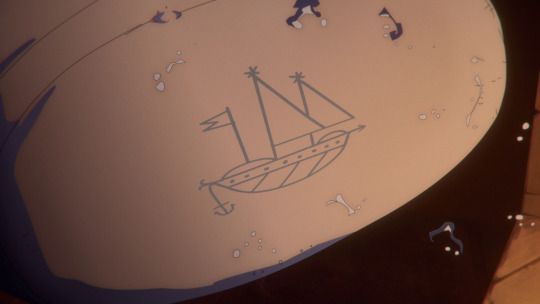

2. Kouzen Zaka, or Azaka
The patron lwa of farmers, but he is also known as a lwa travay, a work lwa. Kouzen Zaka, represented by this vèvè, is the guardian of the fields in Haitian Vodou. The drawing of his symbol showcases elements of agricultural activity, including the earth, machete, sickle, hoe. Zaka is closely tied to work and is revered by farmers and those who rely on agriculture for their livelihood.
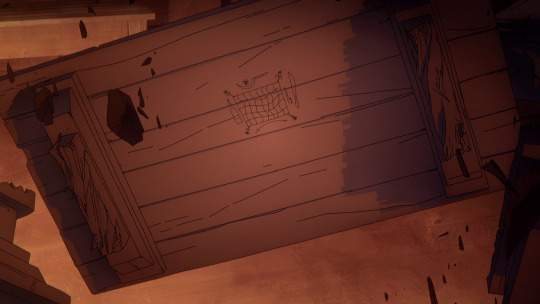

3. Erzulie Dantò or Ezilí Dantor
The main lwa of the Petwo lwa family in Haitian Vodou. She is a powerful and protective mother figure, often depicted holding a knife, symbolizes justice and will forcefully fight to protect her children, who are her loyal followers. She is a single mother, a Haitian peasant who is fiercely independent and takes care of her own, a strong protector of women and children.
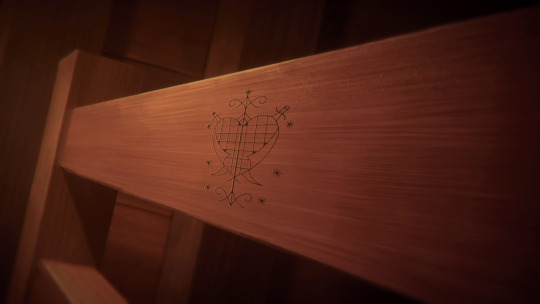
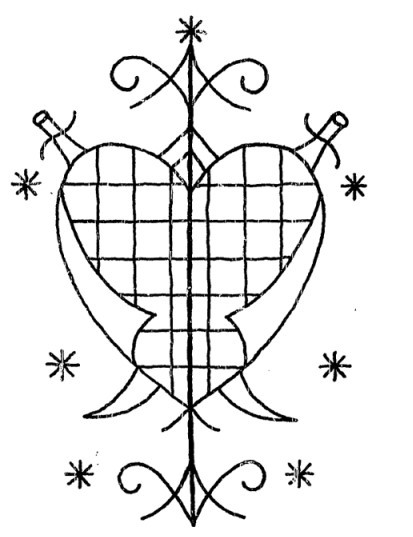
4. Legba: The Guardian of the Gates
Papa Legba, the first spirit to manifest during a Vodou ceremony, holds a special place in the Vodou Pantheon in Haiti. His vèvè symbolizes his role as the barrier between the two worlds, with two perpendicular axes and his cane. Known as a trickster Loa, he usually appears as an old man on a crutch or with a cane, wearing a broad-brimmed straw hat and smoking a pipe, or drinking dark rum. The dog is sacred to him. He carries a sack on a strap across one shoulder from which he dispenses destiny. He is believed to speak all human languages. In Haiti, he is the great elocutioner: Legba facilitates communication, speech, and understanding. During Vodou ceremonies he opens the spiritual gateway that separates the Loas from our physical world.
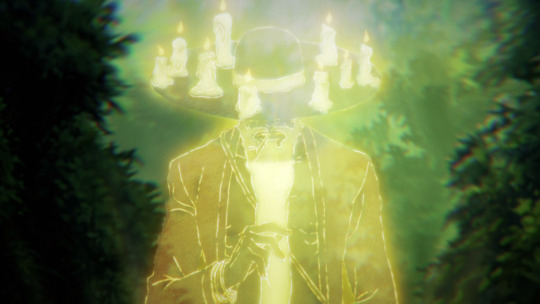
In addition, Papa Legba is the guardian of portals, doors, and crossroads. His role is critical in any Vodou ritual, as he's the one who grants access to the other Loas and allows them to manifest themselves during the ceremony.
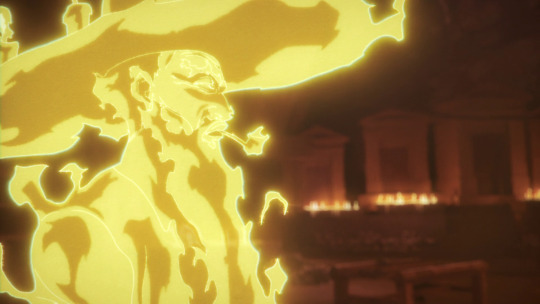
What we hear Annette chant in the series is 'Papa Legba: Ouvè Baryè'a' (Papa Legba: Open the Gate).
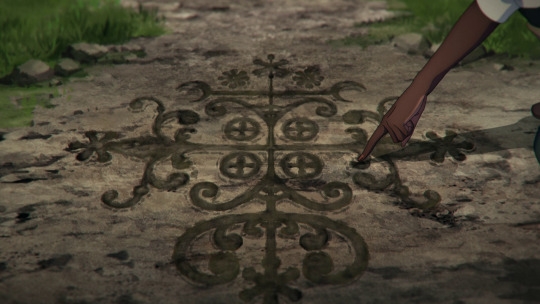
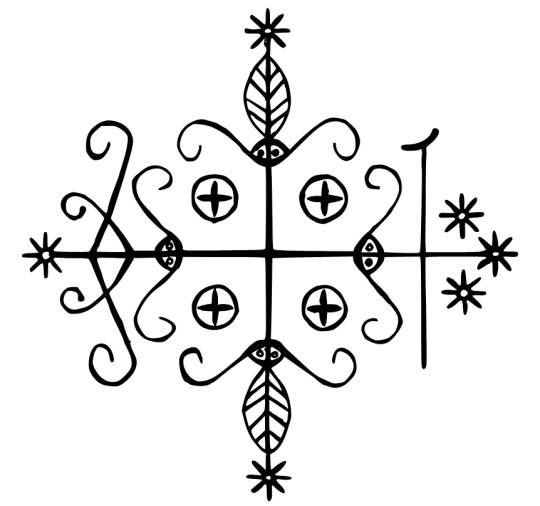
There's a lot more to dive into, but this was a summary.
24 notes
·
View notes
Text
Palo Mayombe: Kongo-derived Afro-Cuban Spirituality — Lawrence Talks!
“This complexity described in the Bantu-Kongo word for person, muntu is a ‘set of concrete social relationships ... a system of systems; the pattern of patterns in being.’ The person is contextualized as a system participating in other systems, a pattern, a ripple that is sourced and from a source.”
— Kimbwandende Kia Bunseki Fu-Kiau, African Cosmology 42
Dr. Kimbwandende Kia Bunseki Fu-Kiau, a Congolese native and scholar of African religion, captures the essence of Kongo cosmology with this quote, and from this cosmological structure lies the roots of the African diasporic religion Palo Mayombe. Just as a person is “a system of systems; the pattern of patterns in being,” ancestral reverence and inclusion positions humans through a multitude of bodies that have come before them. Ancestral veneration is at the core of many African Diasporic spiritualities. Many individuals who grew up in traditional Christian churches are leaving beliefs of Christendom in search for traditional religions that help them connect with their ancestors. Religious and spiritual systems like Ifa, Santeria, Vodou and Conjure have been popularized, sometimes in negative ways by the media, but for the most part these are the spiritualities that people turn to first in their exploration of African traditional religions (ATR). And what is known of Palo Mayombe by the general public is not a large amount of information by any chance. A Google search locates some articles which picture Palo as the “dark side” of Santeria, which is far from the truth. However, to understand Palo as a distinct spiritual system outside of other African diasporic religion, one must understand its BaKongo cosmological foundations.
History of ancient Kongo cosmology
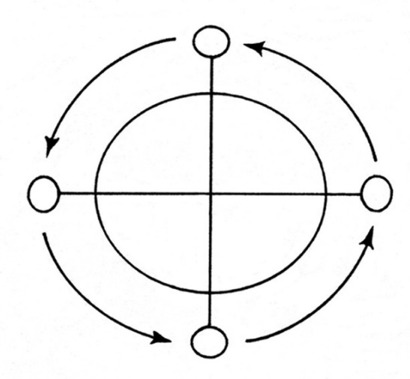
Figure 1: Kongo cosmogram (dikenga)
Fortunately, there is a symbol that captures the essence of Kongo cosmology. The Kongo cosmogram is a cosmological symbol that represents the very patterning of the life process. This symbol is a pre-colonial representation of the cosmogram, as it was conceptualized before European colonization in 1482[1]. It is called the dikenga in the KiKongo language, literally meaning “the turning;” it stands for the cycling of the sun around four cardinal points: dawn, noon, sunset, and midnight when the sun is shining in the world of the dead. Composed of a cross, a circle, and usually arrows, this symbol was found in Kongo material culture well before the contact of colonial Christianity and its cross motif. Anthropologist Robert Farris Thompson, a scholar of Kongo art and religion, says that the “dikenga represents the ultimate graphic design, containing key concepts of Bakongo religious belief, oral history, cosmogony, and philosophy, and depicting in miniature the Bakongo conceptual world and universe” (Thompson 110). The key principle of the dikenga is that nothing ever survives “intact” because nothing ever survives in a fixed form. It is this spiral that is the basic element of Kongo spirituality.
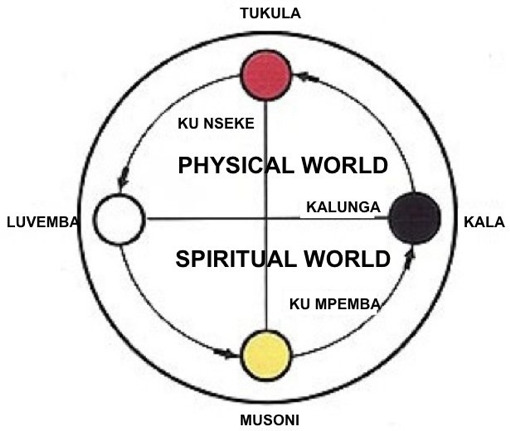
Figure 2: Dikenga
In his seminal piece on Kongo cosmology entitled African Cosmology of the Bantu-Kongo: Principles of Life & Living, Dr. Fu-Kiau explains the motion of the dikenga as the process of ancestralization, of dying and being reborn as an ancestor, through the heating and cooling of existence. This explanation of death and ancestralization is at the core of Palo Mayombe.
Origins of Palo Mayombe
Palo Mayombe is a Kongo derived religion from the Bakongo Diaspora. This religion was transported to the Caribbean during the Spanish slave trade and sprouted in Cuba mostly and in some places in Puerto Rico in the 1500. As the enslaved were forced out of their homelands, their beliefs went with them. Spanish colonialists in Cuba initiated a strategy in the sixteenth century to create mutual aid societies, called cabildos or cofradías, which served to cluster Afro-Cubans into different ethnic categories. This was a strategy of “divide and rule” designed to foster social differences across groups within the enslaved population so that they would not find a unifying focus through which to rebel against the colonial government. In contrast to the extensive blending of diverse African cultures that would be seen in Haiti and Brazil, Cuban cabildos contributed to rich continuations of Yoruba culture in the development of Santería and to largely separate developments of BaKongo beliefs in Palo Mayombe (Fennel). Elements of Catholic beliefs were incorporated into both Santería and Palo Mayombe due to the imposition of the Spanish colonial regime and the cabildo system.
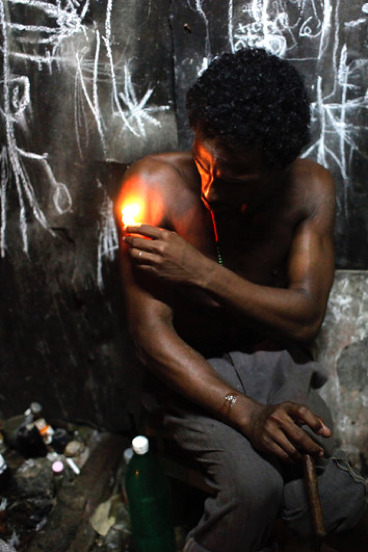
Figure 3 Palo Mayombe Ceremony
Palo Mayombe is very nature-based. Although most African Diasporic religions base rituals and practices in nature, palo (meaning “stick” or “segment of wood” in Spanish) solely depends on the material elements of nature to access the spiritual realm. In Cuba, the Kongo ancestor spirits are considered fierce, rebellious, and independent; they are on the “hot” scale of natural forces. Just as the importance of ancestralization mentioned above, the ancestors are present and inclusive in the practitioner’s life. Nzambi Mpungo is the greatest force in which paleros or paleras (Palo practitioners) call God. Nzambi Mpungo is literally the first ancestor, the initial iteration which all human life flows. Nzambi was viewed as having created the universe, people, spirits, transformative death, and the power of minkisi (ritualized, material objects). The Godhead was thus viewed as being removed from mortal concerns, and supplications were made instead to the ancestor spirits or the intermediary spirits created by Nzambi. Below Nzambi are the mpungus (elemental forces), the ancestors, and the spirits of natural forces (Bettelheim). Each mpungu is similar to an orisha from Yoruba culture due to shared African derived origins, but the two are not the same entity by any means. The mpungu are Afro-Cuban spirits, specific to their diasporic groundings and to the lands of the Diaspora. However, due to their origin
The material tools of Palo Mayombe
Cigars are used to enter into a trance-like state in order to more easily connect with spirits. Special machetes and chains are also used in spirit pots. Candles and rum are essential elements for any Palo ritual. The nganga is used to describe an iron cauldron filled with dirt and specialized sticks; this aids the palero/a in communication with the spirit. In Central America, Cuba and the Caribbean, this cauldron is called a Nganga-Prenda because the culture of modern day and the influence of Latin American's spiritualism in Palo Mayombe.
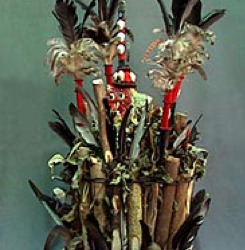
Figure 4: Prenda de Lucero
The Muertos are important entities in the Palo religion. The house of the dead is where the Palo spirits and the ancestors reside. As illustrated through the Kongo cosmogram above, Palo cosmology does not believe in death, but a continual cycle through various forms. It is the process of ancestralization that makes communication with the spirits of the dead accessible. In the Kongo tradition, ancestors, who have access to invisible forces, have the duty to protect the living. In exchange, the ancestor’s descendants have the obligation to take care of the ancestor’s memory and to venerate their earthly representation. This is why bones are another central tool in Palo. After a person has passed, the bones remain, and the bones carries the essence of a soul long after a person is gone. Bones are thus a sacred item in Palo Mayombe and are usually incorporated in Palo rituals. Usually an ancestor altar is an essential piece in the house of a palero/a, along with offerings of food, drink, and special itemize to venerate their ancestors.
Like many ATR’s and magical system, initiation of some kind is needed in order to practice. Guidance from the elders of the religion is highly encouraged, especially since the ways of the spiritual system is nothing like physical realms.
Palo Mayombe and Other Religious Connections
The influence of Palo Mayombe can be found in Central America, Brazil, and Mexico and in the United States. There are different sects of Palo (Palo Monte, Christian-based Palo, Jewish-based Palo) that come from different lineages and distinct engagements with the cultural environment around the practice. There is another Kongo-derived religion in Brazil is Quimbanda, which is a mixture of traditional Kongo, indigenous in India and Latin American spiritualism. Palo Mayombe is the engagement of Kongo influence in the Caribbean and the wider Diaspora. It has its own priesthood and set of rules and regulations. Rules and regulations will vary according to the Palo Mayombe house to which an individual has been initiated into.
Some people who practice Palo might mix other African-derived systems, like Ifa, Vodou, or Santeria, but Palo is a religion in its own right. For example, Yemoja, the orisha of the ocean and motherhood, may be seen as the same energy as Madre de Agua, the mpungo of the ocean and of motherhood. Although these spirits may have similar functions within the religions, they are two separate entites from particular cultural origins and with specific needs. It is quite common for spiritual seekers to be initiated in multiple religions, so it is of great importance to make sure each path is approached. Although there are other religious elements in Palo, it is all included in the practice and not separated within the religion. When Portuguese missionaries brought the message of Christianity to the Kongo/Bantu, the natives embraced it…while continuing their own native practices (Jason R. Young, Rituals of Resistance). So, this pattern of centripetal inclusion is also present in Palo Mayombe. As Iya TeeDee Oshún, a priestess of African diasporic religions, commented in a recent Facebook post:
“Palo is a beautiful road for those of us that it is for. It's also not just some shit you get done real quick before you ‘elevate’ because that's what Iya's spirit guide said to her in the shower. (Not making that up at all.) It's definitely not Iya nor Baba's "witchcraft pot" in the closet or behind the washing machine or above the grease stain in the garage. It's rarely what I hear when people talk to me in Yorabalese” (2019).
Iya’s mention of “Yorbalese” speaks to a common trend of people in the Diaspora making all of African-derived religions about orisha Ifa/Nigeria, but Palo is of the BaKongo Diaspora. The only system close in origin and practice to Palo is African American Hoodoo, which uses similar elements of the heating and cooling of herbs in spiritual work.
Conclusion
When one decides to take a step into the spirituality of Palo Mayombe, the journey really is a deep engagement with their ancestors and with the raw elemental forces of nature. It is a spiritual awareness that provides protection for the community and the self. The ancestors are the root of one’s existence; the root is the culminating point from which all life springs. This Afrocentric view of cosmology in which Palo Mayombe is grounded, deals with the consciousnesses of nature and of ancestry. Anyone who claims Palo Mayombe as a “dark” or unorthodox religion does not understand the Kongo origins of which Palo operates.
[1] The Kongo cosmogram is a pre-Christian symbol, but due to the iconography of the Christian cross, many people overlap their meanings
#Palo Mayombe Kongo-derived Afro-Cuban Spirituality#Palo#ATR#Congo#African Cosmology#Ancestry#African Religions#IFA#Palo Monte#Kongo
8 notes
·
View notes
Text
ffrmc day 25: single chapter banger
Pacifica by cosmogram
e | fitzier | 5k | san francisco bay area, gremlin francis, tech bro james
James couldn’t say what made him go into the cantina. Just that he’d never once been able to leave well enough alone, just that if there was any constancy to him at all it was his talent for finding the raw and flicking it till it bled. The man’s eyes narrowed as James made his way over. Just that he’d always felt others’ disdain the way a moth felt a lantern in the dark.
the character work here my gosh!!! not what you'd expect from a fic set in frickin taco bell and yet! and yet. incredible banter with some of the most incisive, cutthroat character observations i've seen.
5 notes
·
View notes
Text

Day 25 - Horoscope
galaxies and divinations all within a single cosmogram
Hrothtober 2023 Prompt List
12 notes
·
View notes
